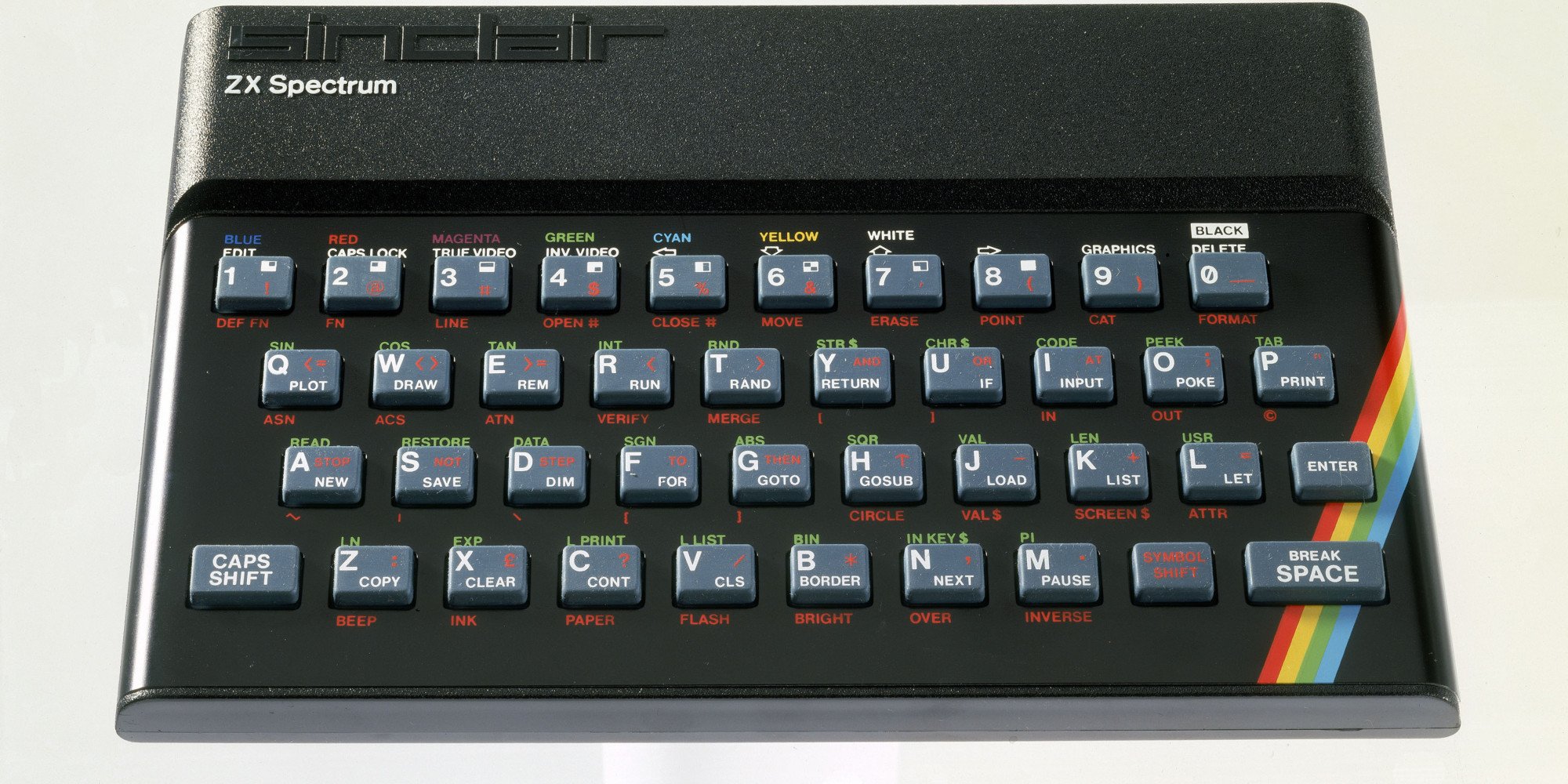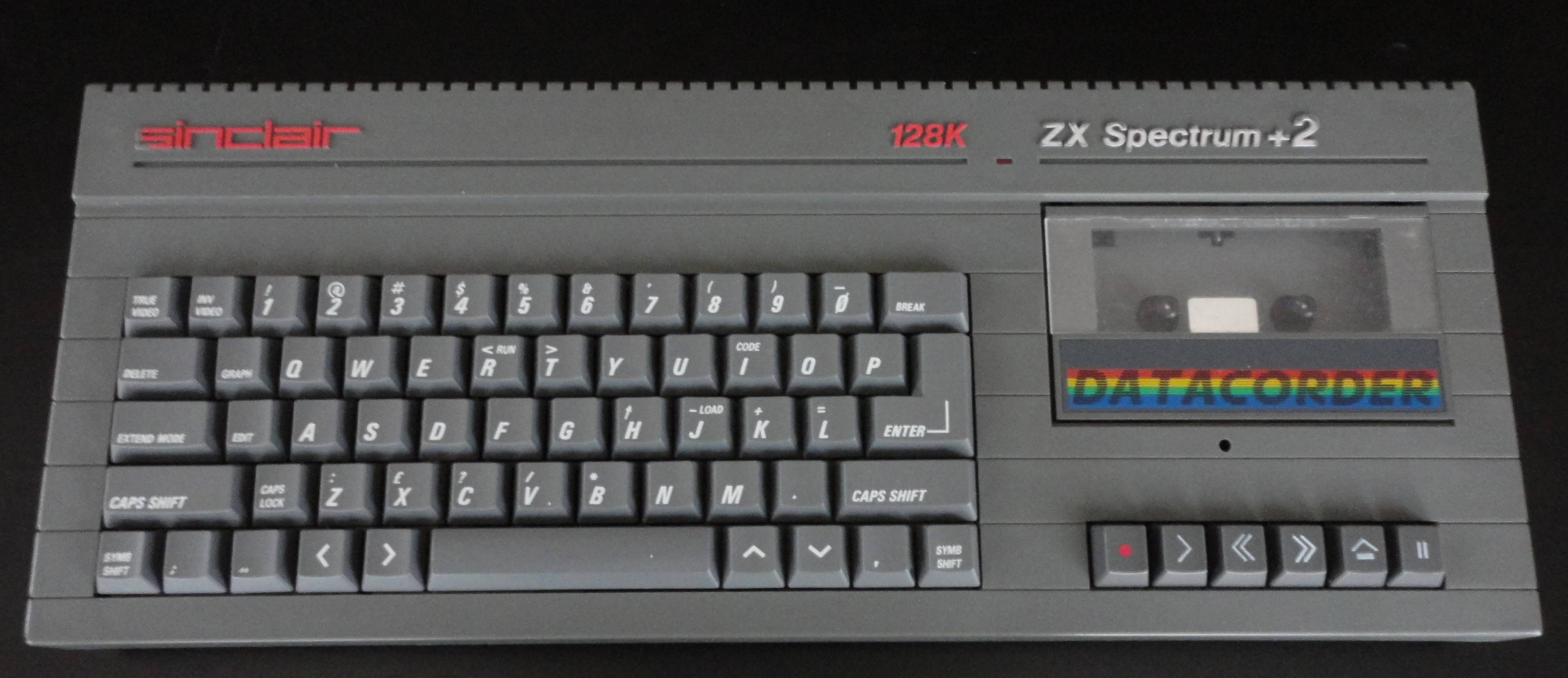ZX Spectrum turned 35 years old

Some of the events that you think that they happened quite recently, in fact, are several years or even decades away from today. For many readers of Geektimes, the ZX Spectrum appeared to be a few years ago, but this is not quite true - today this computer is already 35 years old. For some, he was the first computer to help decide on a future profession - programming, game development, or something else related to IT.
He appeared just in time to become popular. The fact is that in the 70s of the last century, computer equipment was available mainly to scientists, financiers and representatives of other fields. Computers used only for work and nothing else. But by the end of the 70s, another version of operating electronic systems appeared - this is entertainment, in particular, games.
Some manufacturers, realizing that there is a demand for such computers, began the development of specialized systems that make it possible to use the capabilities of computers at home. True, their cost was very high, several thousand, or even tens of thousands of US dollars, so they were available only for very well-to-do buyers.
')
Adherents of the idea that computers for “going to the masses” should drastically fall in price have appeared among entrepreneurs and manufacturers of computer equipment. In addition, a number of representatives of the IT sector believed that computers for home use should be significantly smaller and simpler than the systems that were available at the time.

This idea was first implemented by Sinclair Research , led by Clive Sinclair. Its employees have created a relatively simple device that did not cost much, but it allowed me to start learning the basics of programming. So you could write the programs yourself, and not wait for them to go on sale. Of course, it was possible to develop not only the usual software, but also games.
The computer at Sinclair Research was created by no means immediately; its employees began developing the company in the mid-seventies. The project was delayed for several years, but in 1980 all the works were completed, and the ZX80 computer appeared on the market, the cost of which was only about 80 pounds sterling. It was the world's first PC with a price of up to 100 pounds.

ZX 80 recreated in Minecraft
Developers managed to cheapen computers due to the use of not the most expensive parts and simplification of the PC scheme itself. As a processor, the developers used an inexpensive Zilog Z80 chip, whose core frequency was only 3.25 MHz. The amount of RAM - only 1 KB. If desired, it was possible to install another 16 KB, for which expansion modules were supplied to the market, which, however, cost almost as much as the computer itself. The amount of ROM - 4 kilobytes. And in the memory of the device was already Sinclair BASIC.
Among its other advantages is the low cost and relatively small number of logic chips. Plus, this computer had a very small amount of moving parts. Initially this was done for reasons of economy, but then a small number of such elements became standard. Let me remind you that now we are talking about a computer ZX80.
Buyers quickly appreciated this miniature (for that time) computer. He also knew how to show graphics, but only when the system was not busy doing calculations. There was no video controller here, the graphics were mainly formed by the program part. In order to see the image, it was necessary to connect the computer to the TV. In the 80s, they were already in many, so the user saved money by buying only the main part of the computer without a monitor. Almost immediately after its entry into the market, the first model became very popular. There was a significant excess of demand over supply.

In 1981, a new model, called the ZX81, appeared. It was delivered in the form of a “designer” from which it was possible to assemble a computer, and a ready-made system. The cost of the first option was 49.95 pounds, the second - 69.99. His little by little began to sell not only by mail, but also in retail networks. As for the processor, it used the same Z80 with a core frequency of 3.25 MHz. The RAM was the same as the previous model - 1 KB, which few people liked. But the amount of ROM has grown to 8 kilobytes. In this model, the video controller was also not. Sales of new items exceeded sales of the ZX80 several times.

Finally, the public's favorite ZX Spectrum. The computer went on sale on April 23, 1982. Buyers could order this device by mail, it also fell to retailers. The ZX Spectrum had several new features at once. For example, this computer was adapted to work with color TVs. Actually, that is why it is called Spectrum, and on its body there is a rainbow strip.
A graphics controller has been added to generate the graphics. The amount of RAM was already 16 KB, up to the same figure and increased the amount of ROM. The maximum amount of RAM supported by the ZX Spectrum was 48 KB. In order to store the written programs, it was proposed to use audio tapes and a tape recorder. The keys, by the way, the engineers created from rubber, they replaced the membrane keyboard of the previous two models.
The most interesting thing is that the computer was originally designed for schools and offices. And its gamers have estimated. This is because it was inexpensive, and the created game could be loaded into memory from audio tapes. Plus, the price was low compared to other devices. They began to exchange cassettes, fans appeared at the computer, fan clubs began to form. Some cassettes with software and games began to protect against rewriting. When buying, the user was given a special code that allowed the contents of the cassette to be run on the computer. The cost of the new model was 125 pounds for a model with 16 KB of memory and 175 for a PC with 48 KB of RAM. After some time, prices were reduced to 99.95 and 129.95 pounds.
Two years later, the company released an updated model ZX Spectrum + with 48 KB of RAM by default. There was a new, more comfortable keyboard.

Two years later, the computer appeared ZX Spectrum 128, which was developed in conjunction with Spanish engineers. It added RAM up to 128 KB, doubled the amount of ROM (up to 32 KB). Also worth noting is the appearance of three-channel audio with the standard AY-3-8910, RGB monitor output and MIDI compatibility.
In 1986, the creator of this computer, Clive Sinclair, sold the Amstrad brand to the company. She continued to produce the Spectrum until 1992.

As for the ZX Spectrum, it has become extremely popular in the USSR and other countries. Because of the Cold War, many components of the device were banned in the Soviet Union, and Spectrum itself was also banned. But Soviet engineers were able to quickly develop a domestic clone of this computer, using only the details available in the USSR. These clones were made both at various enterprises and by private individuals - craftsmen, who learned to assemble the apparatus with their own hands. Moreover, their cost was considerable for a Soviet person - about 100 rubles, but this did not prevent the device from gaining popularity.
Already in the 90s for the Spectrum and its copies began to clone games, hits, which at that time were gaining popularity. At that time, game developers could still work in a single person, combining the features of a musician, a graphic designer and, in fact, a developer.
In addition to the USSR, Spectrum became popular in other countries, including South America.

For ZX Spectrum and compatible models produced various accessories. There were a lot of them. For example, for Spectrum created a special printer. True, he printed the spark method, so that the paper required a special, with aluminum coating. For printing, two needles were used, between which tension was created, a spark came and a symbol burned on the paper. The line fit 32 characters.
A separate magnetic tape-based ROM module was also released. It was faster and more productive than a regular audio cassette, but it didn’t get widespread, since tapes were a less expensive and much more affordable option.

There were still modules that add a network interface to the functionality of the computer and a module that allows you to connect a joystick. Yes, not one, but two at once, so that the owner of the device and his friend could master the wisdom of gaming together. All this was a little expensive, so the modules also did not become very popular.

As for software, then, as mentioned above, programs for the ZX Spectrum were written by companies and independent programmers. The number of the second was much higher than the first at the very beginning, when Sinclair Research just brought its computer to the market. As the popularity of this system grew, companies began to show interest in writing PCs for it. Programmers gathered in groups and formed all new enterprises that supplied software and games to the market.
In the second half of the 80s, the number of software for the Spectrum platform began to increase exponentially. The number of games has grown, plots and sound with graphics have been developed. It is interesting that at about the same time systems for protecting programs against illegal copying began to actively appear. Well, in the late 80s - early 90s, the platform began to lose popularity, respectively, not many programs were released under the ZX Spectrum as before. On the other hand, at this time there were many great games and application software, which was continued in our time.
Source: https://habr.com/ru/post/403405/
All Articles